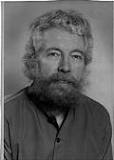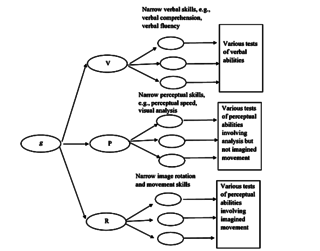
An intelligence quotient (IQ) is a total score derived from a set of standardized tests or subtests designed to assess human intelligence. Originally, IQ was a score obtained by dividing a person's mental age score, obtained by administering an intelligence test, by the person's chronological age, both expressed in terms of years and months. The resulting fraction (quotient) was multiplied by 100 to obtain the IQ score. For modern IQ tests, the raw score is transformed to a normal distribution with mean 100 and standard deviation 15. This results in approximately two-thirds of the population scoring between IQ 85 and IQ 115 and about 2 percent each above 130 and below 70.

The theory of multiple intelligences (MI) proposes the differentiation of human intelligence into specific distinguishable multiple intelligences, rather than defining it as a single general ability. Since 1983, the theory has been popular among educators around the world. In the influential book Frames of Mind: The Theory of Multiple Intelligences (1983) and its sequels, Howard Gardner identifies at least eight distinct intelligences that humans use to survive, thrive and build civilization. The theory describes intelligence as the "brain's toolkit" for creating symbolic thought that is mobilized within one’s specific culture.
Human intelligence is the intellectual capability of humans, which is marked by complex cognitive feats and high levels of motivation and self-awareness. Using their intelligence, humans are able to learn, form concepts, understand, and apply logic and reason. Human intelligence is also thought to encompass their capacities to recognize patterns, plan, innovate, solve problems, make decisions, retain information, and use language to communicate.
The g factor is a construct developed in psychometric investigations of cognitive abilities and human intelligence. It is a variable that summarizes positive correlations among different cognitive tasks, reflecting the assertion that an individual's performance on one type of cognitive task tends to be comparable to that person's performance on other kinds of cognitive tasks. The g factor typically accounts for 40 to 50 percent of the between-individual performance differences on a given cognitive test, and composite scores based on many tests are frequently regarded as estimates of individuals' standing on the g factor. The terms IQ, general intelligence, general cognitive ability, general mental ability, and simply intelligence are often used interchangeably to refer to this common core shared by cognitive tests. However, the g factor itself is a mathematical construct indicating the level of observed correlation between cognitive tasks. The measured value of this construct depends on the cognitive tasks that are used, and little is known about the underlying causes of the observed correlations.
Louis Leon Thurstone was an American pioneer in the fields of psychometrics and psychophysics. He conceived the approach to measurement known as the law of comparative judgment, and is well known for his contributions to factor analysis. A Review of General Psychology survey, published in 2002, ranked Thurstone as the 88th most cited psychologist of the 20th century, tied with John Garcia, James J. Gibson, David Rumelhart, Margaret Floy Washburn, and Robert S. Woodworth.
Intelligence has been defined in many ways: the capacity for abstraction, logic, understanding, self-awareness, learning, emotional knowledge, reasoning, planning, creativity, critical thinking, and problem-solving. It can be described as the ability to perceive or infer information; and to retain it as knowledge to be applied to adaptive behaviors within an environment or context.
The concepts of fluid intelligence (gf) and crystallized intelligence (gc) were introduced in 1943 by the psychologist Raymond Cattell. According to Cattell's psychometrically-based theory, general intelligence (g) is subdivided into gf and gc. Fluid intelligence is the ability to solve novel reasoning problems and is correlated with a number of important skills such as comprehension, problem-solving, and learning. Crystallized intelligence, on the other hand, involves the ability to deduce secondary relational abstractions by applying previously learned primary relational abstractions.
The Wechsler Adult Intelligence Scale (WAIS) is an IQ test designed to measure intelligence and cognitive ability in adults and older adolescents. For children between the ages of 6 and 16, Wechsler Intelligence Scale for Children (WISC) is commonly used.

Raymond Bernard Cattell was a British-American psychologist, known for his psychometric research into intrapersonal psychological structure. His work also explored the basic dimensions of personality and temperament, the range of cognitive abilities, the dynamic dimensions of motivation and emotion, the clinical dimensions of abnormal personality, patterns of group syntality and social behavior, applications of personality research to psychotherapy and learning theory, predictors of creativity and achievement, and many multivariate research methods including the refinement of factor analytic methods for exploring and measuring these domains. Cattell authored, co-authored, or edited almost 60 scholarly books, more than 500 research articles, and over 30 standardized psychometric tests, questionnaires, and rating scales. According to a widely cited ranking, Cattell was the 16th most eminent, 7th most cited in the scientific journal literature, and among the most productive psychologists of the 20th century.
Charles Edward Spearman, FRS was an English psychologist known for work in statistics, as a pioneer of factor analysis, and for Spearman's rank correlation coefficient. He also did seminal work on models for human intelligence, including his theory that disparate cognitive test scores reflect a single general intelligence factor and coining the term g factor.
Philip Ewart Vernon was a British-born Canadian psychologist and author. He studied intellectual ability with a focus on race and intelligence.

The three-stratum theory is a theory of cognitive ability proposed by the American psychologist John Carroll in 1993. It is based on a factor-analytic study of the correlation of individual-difference variables from data such as psychological tests, school marks and competence ratings from more than 460 datasets. These analyses suggested a three-layered model where each layer accounts for the variations in the correlations within the previous layer.
The Kaufman Assessment Battery for Children (KABC) is a clinical instrument for assessing cognitive development. Its construction incorporates several recent developments in both psychological theory and statistical methodology. The test was developed by Alan S. Kaufman and Nadeen L. Kaufman in 1983 and revised in 2004. The test has been translated and adopted for many countries, such as the Japanese version of the K-ABC by the Japanese psychologists Tatsuya Matsubara, Kazuhiro Fujita, Hisao Maekawa, and Toshinori Ishikuma.
The Culture Fair Intelligence Test (CFIT) was created by Raymond Cattell in 1949 as an attempt to measure cognitive abilities devoid of sociocultural and environmental influences. Scholars have subsequently concluded that the attempt to construct measures of cognitive abilities devoid of the influences of experiential and cultural conditioning is a challenging one. Cattell proposed that general intelligence (g) comprises both fluid intelligence (Gf) and crystallized intelligence (Gc). Whereas Gf is biologically and constitutionally based, Gc is the actual level of a person's cognitive functioning, based on the augmentation of Gf through sociocultural and experiential learning.

The Cattell–Horn–Carroll theory, is a psychological theory on the structure of human cognitive abilities. Based on the work of three psychologists, Raymond B. Cattell, John L. Horn and John B. Carroll, the Cattell–Horn–Carroll theory is regarded as an important theory in the study of human intelligence. Based on a large body of research, spanning over 70 years, Carroll's Three Stratum theory was developed using the psychometric approach, the objective measurement of individual differences in abilities, and the application of factor analysis, a statistical technique which uncovers relationships between variables and the underlying structure of concepts such as 'intelligence'. The psychometric approach has consistently facilitated the development of reliable and valid measurement tools and continues to dominate the field of intelligence research.
Domain-general learning theories of development suggest that humans are born with mechanisms in the brain that exist to support and guide learning on a broad level, regardless of the type of information being learned. Domain-general learning theories also recognize that although learning different types of new information may be processed in the same way and in the same areas of the brain, different domains also function interdependently. Because these generalized domains work together, skills developed from one learned activity may translate into benefits with skills not yet learned. Another facet of domain-general learning theories is that knowledge within domains is cumulative, and builds under these domains over time to contribute to our greater knowledge structure. Psychologists whose theories align with domain-general framework include developmental psychologist Jean Piaget, who theorized that people develop a global knowledge structure which contains cohesive, whole knowledge internalized from experience, and psychologist Charles Spearman, whose work led to a theory on the existence of a single factor accounting for all general cognitive ability.

John Leonard Horn was a scholar, cognitive psychologist and a pioneer in developing theories of intelligence. The Cattell-Horn- Carroll (CHC) theory is the basis for many modern IQ tests. Horn's parallel analysis, a method for determining the number of factors to keep in an exploratory factor analysis, is also named after him.
Neurodevelopmental framework for learning, like all frameworks, is an organizing structure through which learners and learning can be understood. Intelligence theories and neuropsychology inform many of them. The framework described below is a neurodevelopmental framework for learning. The neurodevelopmental framework was developed by the All Kinds of Minds Institute in collaboration with Dr. Mel Levine and the University of North Carolina's Clinical Center for the Study of Development and Learning. It is similar to other neuropsychological frameworks, including Alexander Luria's cultural-historical psychology and psychological activity theory, but also draws from disciplines such as speech-language pathology, occupational therapy, and physical therapy. It also shares components with other frameworks, some of which are listed below. However, it does not include a general intelligence factor, since the framework is used to describe learners in terms of profiles of strengths and weaknesses, as opposed to using labels, diagnoses, or broad ability levels. This framework was also developed to link with academic skills, such as reading and writing. Implications for education are discussed below as well as the connections to and compatibilities with several major educational policy issues.
The following outline is provided as an overview of and topical guide to human intelligence:

The g-VPR model is a model of human intelligence published in 2005 by psychology professors Wendy Johnson and Thomas J. Bouchard Jr. They developed the model by analyzing Gf-Gc theory, John Carroll’s Three-stratum theory and Vernon’s verbal-perceptual model.






